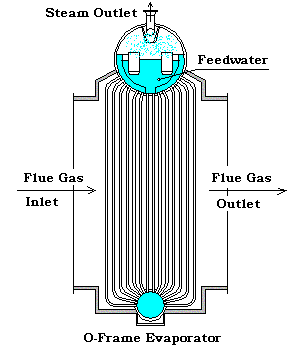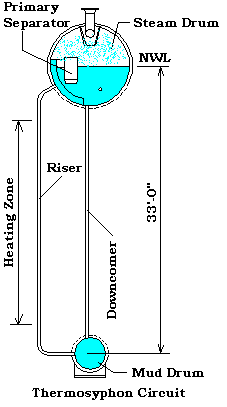Thermosyphon(Natural) Circulation
Conventional, vertical tube boilers are generally designed for natural, "thermosyphon", circulation. This means the water and steam/water circuits are arranged so that the two phase mixture in the steam generating tubes rises to the steam drum by thermal lift of differential density and is replaced by water from the drum by gravity flow. However, it should be noted that many horizontal tube natural circulation boilers have been sucessfully used for years.
Although the nature of a thermosyphon circulation boiler is quite simple, the calculation procedure to check the design to see what the circulation ratio is, can become very complicated. Most designs are such that each row of tubes have a different circulation than all the other rows, but some actually have a different circultion ratio for every tube in the evaporator, which would be difficult to determine, and probably not worth while. That is, of course, that an over all conservative check can be made that is reliable.
To take a look at the details of a thermo syphon evaporator, we will use the ever popular O-Frame design.
 |
We will assume that our evaporator has the following design : Mechanical : SA178 Gr. A, 2.0" OD tubes with 0.120" wall, 28'-0" effective length, 28 tubes per row. 12 rows of finned tubes with 0.049" thick x 0.75" high x 6 fins per in. 2 bare downcomer rows located in the middle of the 12 finned rows. All tubes set on a triangular pitch. 48" ID steam drum and 24" ID mud drum located 33'-0" centerline to centerline. Process Conditions : Gas Side : 800,000 lbs/hr of Gas Turbine Exhaust at 898 °F
Tube Side : Steam is saturated at 630 psia. | ||||||||||||||||
So what we want to do first is select a single circuit in the system to review. We can do that with the sketch shown to the right. The 28 riser tubes would all be the same on this row. The 28 downcomer tubes would likewise be the same. The downcomers , both rows, 56 tubes, feed all the 336 of the riser tubes, so the circuit cannot be isolated from the rest of the circuits. If the heat absorbed by the downcomer tubes is so little that it will not cause a significant difference in the water density of that column, then we will be able to ignore the heat absorbed, for the purposes of checking the circulation. If this is true, then we would have one loss from the drum water down and through the mud drum up to the start of the heating zone of the riser. Another loss could be associated with the heating zone and a third loss covering from the end of the heating zone, up and through the primary separator. |  |
The next step will be to determine the flux rate for each row of tubes through the unit so we can first see if the downcomer is going to be a significant heating tube. Also, we will need the flux rate on a row by row bases to determine the individual tube steam generation.
| Row No. | Flux Rate, Btu/hr/ft2 | Tube Surf., ft2 | Vapor Flow, lbs/hr |
| 1 | 3,232 | 176.9 | 788 |
| 2 | 2,619 | 176.9 | 639 |
| 3 | 2,127 | 176.9 | 519 |
| 4 | 1,730 | 176.9 | 422 |
| 5 | 1,411 | 176.9 | 344 |
| 6 | 1,152 | 176.9 | 281 |
| 7 | 1,781 | 14.7 | N/A |
| 8 | 1,730 | 14.7 | N/A |
| 9 | 889 | 176.9 | 217 |
| 10 | 728 | 176.9 | 178 |
| 11 | 597 | 176.9 | 146 |
| 12 | 490 | 176.9 | 120 |
| 13 | 403 | 176.9 | 98 |
| 14 | 331 | 176.9 | 81 |
The total absorbed duty for the evaporator is 79,268,244 Btu/hr, or 109,288 lbs/hr of steam generated. If we assume, for now, that the circulation ratio is 10:1, then the water flow through the downcomer tubes will be about 1,092,880 lbs/hr, or 19,516 lbs/hr/tube. The pressure losses in the downcomers are, the sudden entry loss, the friction loss, and the sudden exit loss. This results in a pressure loss of 0.225 + 0.927 + 0.113 = 1.265 psi. But, since the head of water in the system is 11.322 psi, no vaporization will occur in the downcomers because the water in the mud drum is well above saturation for the system. The head of water/vapor in the riser leg will be less than that in the downcomer which will cause the water to circulate, thus, a thermosyphon system. How much circulation is what we need to determine.
We can break down the downcomer portion of the circuit as follows:
| Sudden entry into downcomer tube : | 0.5 velocity heads |
| Friction loss in downcomer tube : | friction loss for 30'-0" of tube |
| Sudden exit into mud drum : | 1.0 velocity heads |
For the riser tube, up to the start of the heating zone:
| Sudden entry into riser tube : | 0.5 velocity heads |
| Friction loss in riser tube : | friction loss for varing lengths of tube |
| Bend loss in riser tube : | bend loss for varing angle of bend |
For the riser tube heating zone:
| Friction loss in riser tube : | friction loss for 28'-0" of tube |
For the riser tube, from end of the heating zone to steam drum:
| Friction loss in riser tube : | friction loss for varing lengths of tube |
| Bend loss in riser tube : | bend loss for varing angle of bend |
| Sudden exit into steam drum baffle : | 1.0 velocity heads |
| Primary separator loss : | See Centrifugal Pressure Drop below |
As you can see, we have a major problem in calculating the pressure loss for the primary separators since we do not have an actual design. So we will establish a proceedure to estimate the number of centrifugal separators that we need for this sample. Then we will establish a formula for the pressure loss if we know the number of centrifugals.
Of course, if you are checking an existing design, you would know the number of centrifugal separators it has. It should also be noted that many steam drums don't use centrifugal separators, but rather a system of baffles, especially in low pressure systems.
Number of centrifugal separators required :| Ncent | = | Number of centrifugals |
| Ws | = | Steam Make, lbs/hr |
| Vv | = | Specific volume of vapor, ft3/lb |
| Vl | = | Specific volume of liquid, ft3/lb |
| Cratio | = | Design Circulation ratio |
So for our sample HRSG design, the number of centrifugals required would be,
If you are wondering why we didn't just say up front that, normally, these separators are sized at approximately 1.0 psi drop at design load, the answer is, we needed to get these complicated looking formulas established for our circulation calculations.
The method we have outlined above will give us a conservative answer since we will assume vaporization begins at the start of the heating zone, where it actually starts up the tube aways, and the final vaporization doesn't occur until separation in the centrifugals since it is only here that it is fully back to saturation temperature and pressure.
Since the flux rate on the first row of tubes is greatest, it will have the least circulation ratio, and the last row, where the flux is the least, will have the greatest circulation ratio. With our assumtion of a 10:1 circulation ratio, we will determine what the available loss for the rest of the circuit is,
Head in downcomer = rl * hhead= 49.407 * 33 = 1630.43 lb/ft2 * 1/144 = 11.322 psi
Head in riser up to heating zone = rl * hhead = 49.407 * 2 / 144 = 0.686 psi
Head in riser heating zone = rm * hhead = 1/{[(0.02024 * 9.5) + (0.73206 * 0.5)]/10} * 28 / 144 = 3.483 psi
Head in riser from heating zone = rm * hhead = 1/{[(0.02024 * 9.0) + (0.73206 * 1.0)]/10} * 3 / 144 = 0.228 psi
Head in riser total = 0.686 + 3.483 + 0.228 = 4.397 psi
Left for riser losses = 11.322 - 4.397 - Dpdc= 11.322 - 4.397 - 1.265 = 5.660 psi
The problem with trying to analyze the circulation as we are here, is that the riser circulation is not 10:1, it is actually different for each of the 12 different sets of risers, and the downcomer data is not corrected for the combination of the 12 risers sets feeding the 2 downcomer sets. It is easy to see then, that any analysis must compute all 12 riser sets and the 2 downcomer sets at the same time, or the analysis is incorrect.
Having said this, we will now set up a JavaScript which will balance one riser set against one downcomer set, to provide us with practice in balancing these circuits.
You will notice that when we run the whole evaporator as a single unit, we get a circulation ratio of 18.31:1, which we know from above is not correct. But, we can use our calculator and perform other checks as we would do if we were checking the circulation by hand. If you change the number of riser rows to 1, the lower straight length to 3', the upper to 2', the angle of the upper turn to 45 °, and the lower to 90°. Now for the downcomers, if we divide the number of downcomers by the number of riser rows, we get 6 downcomers to feed each row of risers. So change the downcomers to 1 row with 6 tubes wide. Then change the flux to the first row flux, 3,232 Btu/hr-ft2
We now calculate 10.58:1 circulation ratio for first row. Now change the flux rate to the last row, 331 Btu/hr-ft2 and we get a rate of 56.93:1. These checks, at least give us an approximation of the actual circulations that we would get with a program that can balance all the rows at the same time.
Disclaimer:
The formulas and correlations presented herein are all in the public domain and are to be used only as a learning tool. Note that any product, process, or technology in this document may be the subject of other intellectual property rights reserved by sponsors or contributors to this site. This publication is provided as is, without any warranty of any kind, either expressed or implied, including, but not limited to, the implied warranties of fitness for a particular purpose, or non-infringement.
The formulas, correlations, and methods presented herein should not be considered as being recommended by or used by the sponsors of this site. The purpose of this site is educational and the methods may or may not be suitable for actual design of equipment. Only a fired heater design engineer is qualified to decide if a calculation or procedure is correct for an application.